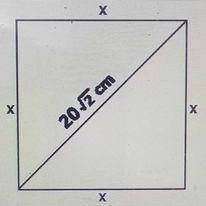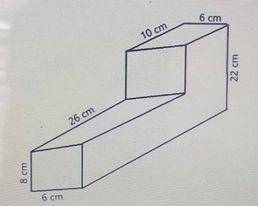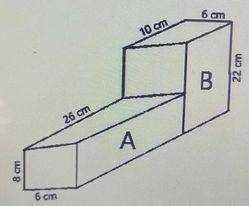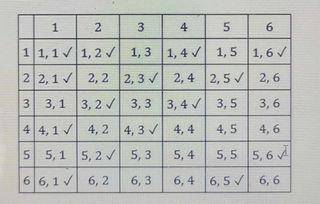Find the area and perimeter of a square whose length of diagonals is 20\(\sqrt2\) cm
800 cm\(^2\), 80 cm
400 cm, 80 cm\(^2\)
80 cm, 800 cm\(^2\)
400 cm\(^2\), 80 cm
Correct answer is D

Using Pythagoras theorem
⇒ \((20\sqrt2)2 = x^2 + x^2\)
⇒ 800 = \(2x^2\)
⇒ 400 = \(x^2\)
⇒ x = \(\sqrt400\) = 20 cm
∴ Area of a square = \(x^2 = 20^2 = 400 cm^2\)
∴ Perimeter of a square = 4x = 4 x 20 = 80 cm

Find the volume of the composite solid above.
2048 cm\(^3\)
2568 cm\(^3\)
2672 cm\(^3\)
1320 cm\(^3\)
Correct answer is B

Volume of the composite solid = Volume of A + Volume of B
Volume of a cuboid = length x breadth x height
Volume of A = 6 x 26 x 8 = 1248 cm\(^3\)
Volume of B = 6 x 10 x 22 = 1320 cm\(^3\)
∴ Volume of the composite solid = 1248 + 1320 = 2568 cm\(^3\)
Two dice are tossed. What is the probability that the total score is a prime number.
\(\frac{5}{12}\)
\(\frac{5}{9}\)
\(\frac{1}{6}\)
\(\frac{1}{3}\)
Correct answer is A

Total possible outcome = 6 x 6 = 36
Required outcome = 15
∴ Pr(E) = \(\frac{15}{36} = \frac{5}{12}\)
11
13
12
14
Correct answer is B
An exterior angle of a n-sided regular polygon = \(\frac{360}{n}\)
For (n - 1) sided regular polygon = \(\frac{360}{n - 1}\)
For (n + 2) sided regular polygon = \(\frac{360}{n + 1}\)
⇒ \(\frac{360}{n - 1} - \frac{360}{n + 2}\) = 6 9Given)
⇒ \(\frac{360(n + 2) - 360(n - 1)}{(n - 1)(n + 2)}\)
⇒ \(\frac{360n + 720 - 360n + 360}{(n - 1)(n + 2)}\)
⇒ \(\frac{1080}{(n - 1)(n + 2)} = \frac{6}{1}\)
⇒ 1080 = 6 (n - 1)(n + 2)
⇒ 180 = (n - 1)(n + 2)
⇒ 180 = n\(^2\)+ 2n - n - 2
⇒ 180 = n\(^2\) + n - 2
⇒ n\(^2\)b+ n - 2 - 180 = 0
⇒ n\(^2\) + n - 182 = 0
⇒ n\(^2\) + 14n - 13n - 182 = 0
⇒ n (n + 14) - 13 (n + 14) = 0
⇒ (n - 13) (n + 14) = 0
⇒ n - 13 = 0 or n + 14 = 0
⇒ n = 13 or n = -14
∴ n = 13 (We can't have a negative number of side)
JAMB Subjects
Aptitude Tests
Latest Jobs
Indorama Eleme Fertilizer & Chemicals Limited (IEFCL) Graduate Engineer Internship Program 2024
Diploma Engineer Internship Program at Indorama Eleme Fertilizer & Chemicals Limited (IEFCL)
Admin Officer - Airline Industry at Ascentech Services Limited
Area Sales Manager at Airtel Nigeria
State Business Manager at Airtel Nigeria
Inventory Manager at a Reputable Agricultural Company
Supply Chain Officer at Kellogg's Tolaram Nigeria Limited (KTNL)
Warehouse Manager at Shulifang Biotechnology FZE
Capability Development & Execution Excellence Manager (Rivers) at Airtel Nigeria
Regional Security Manager - Northeast Region at Airtel Nigeria